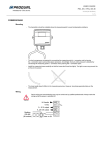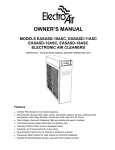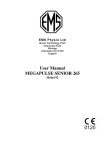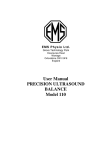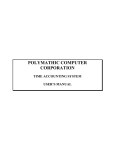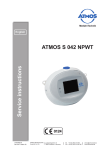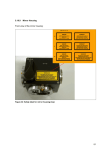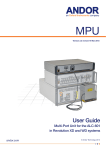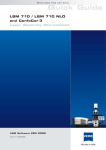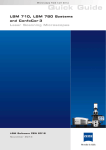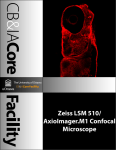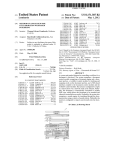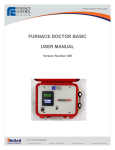Download LMM5 User Manual
Transcript
Software Manual—RS232 Laser Merge Module Document # SU-256521-09 Rev A The information presented in this document is proprietary to Spectral Applied Research Inc. and cannot be used for any purpose other than that for which it is intended. 10 North Rivermede Road Concord, Ontario, CANADA L4K 2H2 www.SpectralAppliedResearch.com Software Manual—RS232 Laser Merge Module Document # SU-586521-09 Rev A Table of Contents 1. INTRODUCTION .................................................................................1 2. CONTROLS .........................................................................................1 2.1 2.2 2.3 2.4 2.5 Shutters .............................................................................................................................. 1 Neutral Density Filters ..................................................................................................... 1 Power Monitor .................................................................................................................. 2 Microcontroller Interfaces ............................................................................................... 2 RS-232 Interface................................................................................................................ 2 3. RS232 PROTOCOLS ...........................................................................2 3.1 Control Commands........................................................................................................... 2 3.1.1 Command: Shutter Control ..................................................................................... 3 3.1.2 Command: Shutter Status........................................................................................ 3 3.1.3 Command: Change Transmission ........................................................................... 3 3.1.4 Command: Read Transmission ............................................................................... 4 3.1.5 Command: Get Laser Line Setup............................................................................ 4 3.1.6 Command: Read Power Monitor ............................................................................ 5 3.2 Trigger Commands........................................................................................................... 5 3.2.1 Exposure Configure .................................................................................................. 5 3.2.2 Trigger In Configure ................................................................................................ 5 3.2.3 Trigger Out Configure ............................................................................................. 6 3.2.4 Read Trigger In Configuration................................................................................ 7 3.2.5 Read Trigger Out Configuration............................................................................. 7 3.2.6 Read Exposure Configuration ................................................................................. 7 3.3 Other Commands.............................................................................................................. 7 3.3.1 Home Motor .............................................................................................................. 7 4. TRIGGER IMPLEMENTATION GUIDE ................................................8 4.1 Auxiliary connector .......................................................................................................... 8 4.2 Programmable TTL.......................................................................................................... 8 4.2.1 Trigger In................................................................................................................... 8 4.2.2 Trigger Out................................................................................................................ 9 4.2.3 Trigger Flow Charts ............................................................................................... 10 4.2.4 Programming........................................................................................................... 15 List of Figures Figure 1: Trigger In, Cycle driven flow charts ........................................................................ 10 Figure 2: Trigger In, State driven flowcharts .......................................................................... 12 Figure 3: Trigger Out flowchart................................................................................................ 14 i The information presented in this document is proprietary to Spectral Applied Research Inc. and cannot be used for any purpose other than that for which it is intended. Software Manual—RS232 Laser Merge Module, model LMM5 Document # SU-586521-01 Rev A 1. INTRODUCTION This manual is a compilation of material on the programming of the Laser Merge Module, model LMM5 using the RS-232C interfaces, and the triggering capability available via TTL and dedicated BNC connectors on the control unit. The document is presented in major segments starting with a description of the pertinent controls. 2. CONTROLS The LMM5 can be controlled either manually or by a computer via a RS-232 or TTL interfaces. The following is a compilation of the programmable controls and a brief description of their function. All references to controls and indicators are highlighted in bold in the descriptions below. The following figures show the front and rear panels of the control unit. 2.1 Shutters Mechanical shutters are built into the LMM5. A shutter is installed for each laser at the exit from the laser compartment. A master shutter is also installed prior to the exit from the head unit. The laser shutters are controlled by lighted momentary pushbutton switches located on the front panel of the control unit or by the computer. The pushbuttons are identified by the label Laser Select and by the laser position number (1-5). The light is red when the shutter is open. No light is showing when the shutter is closed. Pushing the pushbutton will toggle the status of the shutter. The master shutter is initialised open about 5 seconds after power is applied by the Master Key switch and its indicator turns red. Any other shutter can now be selected as required. The Master Shutter pushbutton controls the master shutter in the same manner as the other shutters. If the Remote Interlock is open circuited, then all the shutters close immediately. 2.2 Neutral Density Filters Neutral density filter wheels are installed for each laser in order to provide intensity control. The manual controls for these mechanisms are located on the control unit. The controls consist of a three-position momentary toggle switch labelled Intensity Adjust to select increasing or decreasing intensity direction, or off. The toggle switch is held to continue the motion in the selected direction. It will stop when either the minimum or maximum point has been reached. A particular filter wheel is selected by opening the associated shutter. If more than one shutter is open, the filter wheel associated with the last one opened may be driven. A green indicator is provided for each filter wheel so that the operator can readily confirm which wheel is selected. The indicators are identified by the label Intensity Select and by the laser position number (1-5). When a filter wheel is selected and the momentary toggle switch pushed for increasing or decreasing intensity, the speed of the wheel starts off slow but increases if the switch is held in place. The wheel takes about 10 seconds to change from maximum to minimum or vice versa. 1 Software Manual—RS232 Laser Merge Module, model LMM5 Document # SU-586521-01 Rev A 2.3 Power Monitor The LMM5 contains a built-in power monitor on the front panel of the head unit. An input connector is provided to accept the fiber cable connected to the LMM5 output. A BNC connector is provided to allow measurement of the DC voltage produced by the LMM5 output. The power monitor consists of a photodiode with neutral density filter and a resistive load. Thus, the current produced by the photodiode is converted to a voltage. This can be measured by a voltmeter attached to the power monitor output connector or via an analog-to-digital converter by the computer. 2.4 Microcontroller Interfaces Two BNC connectors are provided on the rear panel of the control unit. Both are used to coordinate the LMM5 with other experimental apparatus. The Trigger In is used to control the on/off cycle for laser illumination based on externally generated conditions. A set of exposure states is defined and the trigger steps through these states in order. The Trigger Out can be set in two modes, clock driven or state driven. For state driven, a TTL pulse will be sent every time the exposure state is changed. For clock driven, a TTL pulse is sent out at a regularly interval. 2.5 RS-232 Interface A 9-pin D subminiature connector (female), labelled Serial, is provided on the rear panel of the control unit to allow serial communication with the microcontoller. The arrangement is a standard DTE to DCE configuration and requires a straight cable to connect the control unit to a computer. The pin-out of this connector is as follows: pin 2--Rx from DTE; pin 3—Tx to DTE; pin 5—ground. 3. RS232 PROTOCOLS 3.1 Control Commands For further information contact David Cooper at [email protected] or 905.326.5040 x405 Command structure: The command structures listed in this document use binary values to issue the commands. However many serial communication programs prefer to send ASCII data. Therefore to send one binary byte the control software should always send the equivalent hexadecimal value in ASCII representation. This requires sending two bytes for every single byte of binary data. Any command sent to the controller should terminate with a carriage return (ASCII value 13). For example, to send the binary sequence 0x1A,0xFF,0x00,Ox12 – the serial program should send the ascii string “1AFF0012<CR>” – or in ASCII values: 49,65,70,70,48,48,49,50,13 Serial settings are 19,200 bps, no flow control, one stop bit, no parity, 8 data bits 2 Software Manual—RS232 Laser Merge Module, model LMM5 Document # SU-586521-01 Rev A 3.1.1 Command: Shutter Control Set the open/closed states of the shutters Op Code: 0x01 Data: 1 byte representing bit field for states of up to 8 shutters, “1” indicates shutter open and “0” means shutter closed. Return: One Ack byte is sent as 0x01 and indicates that the command was processed and 0xFF if there is any error Example: Send: 0x01 0x02 – opens shutter 2 and closes all others Receive: 0x01 – operation is acknowledged Send: 0x01 0x09 – opens shutter 4 and 1 and closes all others Receive: 0x01 Notes: Shutters take 1-2 milliseconds to open so this command does not wait to see if shutters are set successfully before acknowledging. Use the shutter status command to verify shutter states. 3.1.2 Command: Shutter Status Read the open/closed states of the shutters Op Code: 0x02 Data: None Return: 2 bytes. First byte is an Ack byte, 0x02. Second byte gives shutter states in a bit field as in shutter control. Example: Send: 0x02 Receive: 0x02 0x02 – shutter 2 is open, all others are closed Send: 0x02 Receive: 0x02 0x09 – shutter 1 and 4 are open, all others closed Notes: This command returns the status of the photodetector sensor on each shutter. It takes 1 – 2 milliseconds for this sensor to respond to a shutter operation. 3.1.3 Command: Change Transmission Set the Transmission of a specific laser line. This may be done through a filter wheel or an AOTF. Op Code: 0x04 3 Software Manual—RS232 Laser Merge Module, model LMM5 Document # SU-586521-01 Rev A Data: 3 bytes. First specifies the lines to change attenuation (line 1 is 0x00). Second and third give transmission from 0 to 1000 (0 is minimum transmission and 1000 is maximum). Byte order is big endian (high byte first). Return: 1 byte Ack 0x04 normally and 0xFF if there is an error. An error could occur if the device loses its position for the filter wheel or fails to set the voltage to an AOTF. When controlling a filter wheel, this command may take several seconds to acknowledge as it waits until the wheel movement is complete before acknowledging. Example: Send: 0x04 0x03 0x02 0xBC – sets the transmission to 700 (70.0%) on line 4. 0x02 is high byte (equals 512) and 0xBC is low byte (equals 188 so 512+188=700). Receive: 0x04 – Ack Notes: Transmission is logarithmic for a filter wheel. For our 20dB wheels 50% = 10dB and is actually 10% transmission. When the device with filter wheels is first turned on, the filter wheels automatically rotate to find the home sensor and then return to their position at initial power up. The AOTF (if applicable) is set to minimum transmission at startup. 3.1.4 Command: Read Transmission Read the current transmission setting for a specific laser line. This may be done for a filter wheel or an AOTF. Op Code: 0x05 Data: 1 byte to indicate which line to return Return: 3 bytes. First is an ack 0x05 for normal operation and 0xFF for error. Next two bytes give transmission from 0 to 1000 in big endian format as in change transmission command. Example: Send: 0x05 0x03 – read transmission of line 4 Receive: 0x05 0x02 0xBC – transmission is 700 3.1.5 Command: Get Laser Line Setup Read which laser line wavelength is installed in which slot. Op Code: 0x08 Data: None Return: 17 bytes. First is an Ack 0x08 for normal operation and 0xFF for error. Each two bytes after gives the wavelength of the laser in the corresponding line for a total of 8 lines. The byte order is big endian (high byte first). The wavelength is in angstroms so 4610 corresponds to 461.0 nm. A value of zero indicates that no laser line is assigned to that slot. Example: Send: 0x08 4 Software Manual—RS232 Laser Merge Module, model LMM5 Document # SU-586521-01 Rev A Receive: 0x08 0x15 0xEA 0x13 0x2E 0x11 0x30 0x00 0x00 0x00 0x00 0x00 0x00 0x00 0x00 0x00 0x00 – line 1 is 561 nm, line 2 is 491 nm, line 3 is 440 nm and lines 4-8 are not available. 3.1.6 Command: Read Power Monitor Read the voltage on the power monitor photodiode Op Code: 0x0A Notes: not currently available with rs232 control. Future versions will have this capability. 3.2 Trigger Commands These commands define the function of the trigger in and out BNCs from the control box. Contact Spectral Applied Research for more information on trigger controls. 3.2.1 Exposure Configure Op-Code: 0x21 (33) Bytes Sent: 1+3M (1<=M<=20) Bytes: 1: # of exposure states (value of 1 to M) 2 to (M+1): exposure states (M+2) to (3M+1): exposure time Description: This command defines the exposure parameters that the unit cycles through upon receiving a trigger in. The number of exposure states determines the number of different shutter states that the unit will go through before repeating the cycle. The exposure states give the shutter states for each exposure in the cycle. The format is the same as the shutter control command so each bit in the byte indicates the state of the corresponding shutter. The exposure time gives a series of unsigned 2-byte integers that define the exposure time of each state. The exposure time is in 0.1 msec increments for a maximum of a bit more than 6.5 seconds. The behaviour of the exposure time depends on the trigger in mode (see below). In Step mode, the exposure time defines how long the shutter stays open before reverting to an all closed state. In Cycle mode, the exposure determines how long to wait before moving to the next state. Example: 0x21;0x02;0x17;0x06;0x10;0x00;0x03;0xAD: Defines two exposure states- shutter 1 and 5 open then shutter 2 and 3 open with exposure times of 0.4096sec and 0.0941sec respectively. 3.2.2 Trigger In Configure Op-Code: 0x22 (34) Bytes Sent: 3 5 Software Manual—RS232 Laser Merge Module, model LMM5 Document # SU-586521-01 Rev A Bytes: 1: Enable(1)/Disable(0) Trigger In 2: # of trigger input before action 3: Define step(0) or cycle(1) trigger Description: This command enables or disables the trigger in input and defines the trigger behaviour. Send 0 in the first byte to disable the trigger in and 1 to enable it. Step trigger is defined by a 0 in the third byte and Cycle mode by a 1. See trigger documentation for behaviour of each mode. The number of trigger inputs before action determines the number of trigger inputs to receive before taking action such as starting a state sequence or moving to the next state. Example: 0x22;0x01;0x02;0x00: Enables a Step trigger and requires two trigger in events for each step. Notes: Trigger In is positive edge TTL. There is a jitter of up to 50 microseconds in processing the trigger in. Motor control function and shutter control (manual and usb) are disabled while trigger is active. Motor control is deactivated due to limited timing resources and speed of the MCU and shutter control is deactivated since shutter states are determined by the exposure configuration. 3.2.3 Trigger Out Configure Op-Code: 0x23 (35) Bytes Sent: 4 Bytes: 1: Enable(1)/Disable(0) Trigger Out 2: State(0)/Clock(1) driven mode 3-4: Exposure Time Description: This commands enables the hardware trigger out. The trigger out can either be state driven so a trigger out occurs every time the shutter changes exposure state, or clock driven with the period between trigger outs is determined by exposure time. For state driven, the exposure time determines the delay from the state change to the trigger out. The exposure time is in 0.1 msec increments with a maximum of a bit more than 6.5 sec. The trigger out is a TTL pulse with a width of a few microseconds. Example: 0x23;0x01;0x00;0x03;0xAD: Define a state driven trigger out with a delay of 0.0941 sec 0x23;0x01;0x01;0x00;0xC8: Define a clock driven trigger out at 50 Hz (20 msec delay) Notes: Motor movement is disabled when trigger out is active 6 Software Manual—RS232 Laser Merge Module, model LMM5 Document # SU-586521-01 Rev A 3.2.4 Read Trigger In Configuration Op-Code: 0x25 (37) Bytes Sent: None Return: Returns the state of the trigger in setup in the same format as the trigger in configuration command Example: Send 0x25 Receive 0x25;0x01;0x02;0x00 3.2.5 Read Trigger Out Configuration Op-Code: 0x26 (38) Bytes Sent: None Return: Returns the state of the trigger out setup in the same format as the trigger out configuration command Example: Send 0x26 Receive 0x26;0x01;0x00;0x03;0xAD: 3.2.6 Read Exposure Configuration Op-Code: 0x27 (39) Bytes Sent: None Return: Returns the exposure parameters in the same format as the exposure configuration command Example: Send: 0x27 Receive: 0x27;0x02;0x17;0x06;0x10;0x00;0x03;0xAD 3.3 Other Commands 3.3.1 Home Motor Op-Code: 0x11 Bytes Sent: 1 Bytes Received: 2 Description: This command homes the specified motor and returns the number of steps to reach home. Repeating this command gives the number of steps for a complete revolution. Notes: This command is only intended to be used for unit calibration and shouldn’t be used by the end-user. 7 Software Manual—RS232 Laser Merge Module, model LMM5 Document # SU-586521-01 Rev A 4. TRIGGER IMPLEMENTATION GUIDE There are two types of TTL triggers available for the LMM5 controller. The 15 pin auxiliary connector provides TTL control of the laser shutters and adjustments of the laser intensity. There are two BNC connectors that provide programmable functionality. One BNC is an output and the other is an input. The behaviour of these TTL connections can be programmed to a variety of functions through the serial RS232 or USB connection to a computer. 4.1 Auxiliary connector A 15-pin D subminiature connector (female), labelled Auxiliary Controls, is provided on the rear panel of the control unit to allow auxiliary control via TTL inputs of the shutters and ND wheels. The TTL input signals are OR’d with the microcontroller signals and the front panel controls. A TTL High will open the corresponding shutter and a TTL Low will close the shutter. However, the microcontroller and front panel controls must be set to Closed to avoid overrides. The pinout of the 15-pin connector is shown in the following table. Pin Function Pin Function Pin Function Pin Function 1 Shutter 1 4 Shutter 4 7 Intensity -ve 10 - Not used 2 Shutter 2 5 Shutter 5 8 Signal return 15 Not used 3 Shutter 3 6 Intensity +ve 9 Not used 4.2 Programmable TTL The LMM controller has BNC connections for both trigger in and trigger out. Both are used to coordinate the LMM with other equipment such as cameras and experimental apparatus. Sections 4.2.1 and 4.2.2 give a description of the functions, 4.2.3 shows flowcharts for the triggers and 4.2.4 gives detailed programming information. 4.2.1 Trigger In The “trigger in” BNC is used to control the on/off cycle for laser illumination based on externally generated conditions. A set of exposure states is defined, and the trigger steps through these states in order. The command structure is as follows. 4.2.1.1 Defining the exposure cycle Data: 1 byte specifies the number of exposure states, M, to cycle through (1 to 20), M bytes defining each of the exposure states using the same format as the Shutter Control command, and 2M bytes to specify the exposure times for each shutter state 8 Software Manual—RS232 Laser Merge Module, model LMM5 Document # SU-586521-01 Rev A The exposure times will be set in tenths of milliseconds and a zero will indicate to stay in that exposure state until the next trigger. 4.2.1.2 Configuring the trigger Data: 1 byte to enable/ disable the external trigger, 1 byte to specify N which is the number of trigger inputs to accumulate before initiating action, 1 byte specifying whether to step or cycle through the exposure states. When enabled, USB and manual control of the exposure is disabled. This means the shutters and ND wheels will not be controllable. The step mode will advance to the next exposure state on each trigger and then repeat the cycle when all states are complete. The exposure duration is determined by the set time after which the exposure state reverts to all closed while waiting for the next trigger. The cycle exposure mode will cycle through all the defined exposure states after each trigger. Further triggers will be disabled while cycling through exposure states. 4.2.2 Trigger Out The trigger out can be set in two modes, clock driven or state driven. 4.2.2.1 State driven A TTL pulse will be sent every time the exposure state is changed. 4.2.2.2 Clock Driven A TTL pulse is sent out at a regularly interval. 4.2.2.3 Configuring the Trigger 1 byte to enable/disable the trigger out, 1 byte to specify state/ clock driven, 2 bytes to specify the time between pulses in milliseconds between 0.1 milliseconds and 1 minute. Control of the ND wheels will be disabled if trigger out is enabled. This is a bit of a bother but is driven by limited resources on the microcontroller. 9 Software Manual—RS232 Laser Merge Module, model LMM5 Document # SU-586521-01 Rev A 4.2.3 Trigger Flow Charts Figure 1: Trigger In, Cycle driven flow charts Shutters Closed If State Trigger Out Enabled Trigger In Decrement Trigger Out Timer Shutter in State(0) Decrement Exposure Timer Trigger Out? Exp and Trig Out? No Yes If State Trigger Out Enabled Yes Decrement Trigger Out Timer Shutter in State(1) Decrement Exposure Timer Trigger Out? Exp and Trig Out? Yes No No If State Trigger Shutter in State(N-1) No Yes Trigger Out Out Enabled Decrement Trigger Out Timer 10 Software Manual—RS232 Laser Merge Module, model LMM5 Document # SU-586521-01 Rev A Decrement Exposure Timer Exp and Trig Out? Trigger Out? No Yes No Trigger Out If State Trigger Out Enabled Yes Shutters Closed Decrement Trigger Out Timer Trigger Out? No Yes Trigger Out Trigger In Ignore if Trigger Out pending or Cycle not finished Shutter in State(0) If State Trigger Out Enabled Decrement Trigger Out Timer 11 Software Manual—RS232 Laser Merge Module, model LMM5 Document # SU-586521-01 Rev A Figure 2: Trigger In, State driven flowcharts Note: Exposure Timer is reset if new trigger occurs before timer counts down Shutters Closed If State Trigger Out Enabled Decrement Trigger Out Timer Shutter in State(0) Trigger In Decrement Exposure Timer No Trigger Out? Exposure ? Yes No Trigger Out Yes Shutters Closed Trigger In Ignore if Trigger Out pending If State Trigger Out Enabled Decrement Trigger Out Timer Shutter in State(1) Decrement Exposure Timer Exposure ? Trigger Out? No No Yes Trigger Out Yes Shutters Closed 12 Software Manual—RS232 Laser Merge Module, model LMM5 Document # SU-586521-01 Rev A Shutters Closed If State Trigger Out Enabled Decrement Trigger Out Timer Shutter in State(0) Trigger In Decrement Exposure Timer No Trigger Out? Exposure ? Yes No Trigger Out Yes Shutters Closed Trigger In Ignore if Trigger Out pending If State Trigger Out Enabled Decrement Trigger Out Timer Shutter in State(1) Decrement Exposure Timer Exposure ? Trigger Out? No No Yes Trigger Out Yes Shutters Closed 13 Software Manual—RS232 Laser Merge Module, model LMM5 Document # SU-586521-01 Rev A Figure 3: Trigger Out flowchart Decrement Trigger Out Timer Trigger Out? No Yes Trigger Out Decrement Trigger Out Timer Trigger Out? No Yes Trigger Out 14 Software Manual—RS232 Laser Merge Module, model LMM5 Document # SU-586521-01 Rev A 4.2.4 Programming These commands define the function of the trigger in and out BNCs from the control box. See the LMM5 programming guide for more information on sending commands to the LMM5. 4.2.4.1 Exposure Configure Op-Code: 0x21 (33) Bytes Sent: 1+3M (1<=M<=20) Bytes: 1: # of exposure states (value of 1 to M) 2 to (M+1): exposure states (M+2) to (3M+1): exposure time Description: This command defines the exposure parameters that the unit cycles through upon receiving a trigger in. The number of exposure states determines the number of different shutter states that the unit will go through before repeating the cycle. The exposure states give the shutter states for each exposure in the cycle. The format is the same as the shutter control command so each bit in the byte indicates the state of the corresponding shutter. The exposure time gives a series of unsigned 2-byte integers that define the exposure time of each state. The exposure time is in 0.1 msec increments for a maximum of a bit more than 6.5 seconds. The behaviour of the exposure time depends on the trigger in mode (see below). In Step mode, the exposure time defines how long the shutter stays open before reverting to an all closed state. In Cycle mode, the exposure determines how long to wait before moving to the next state. Example: 0x21;0x02;0x17;0x06;0x10;0x00;0x03;0xAD: Defines two exposure states- shutter 1 and 5 open then shutter 2 and 3 open with exposure times of 0.4096sec and 0.0941sec respectively. 4.2.4.2 Trigger In Configure Op-Code: 0x22 (34) Bytes Sent: 3 Bytes: 1: Enable(1)/Disable(0) Trigger In 2: # of trigger input before action 3: Define step(0) or cycle(1) trigger 15 Software Manual—RS232 Laser Merge Module, model LMM5 Document # SU-586521-01 Rev A Description: This command enables or disables the trigger in input and defines the trigger behaviour. Send 0 in the first byte to disable the trigger in and 1 to enable it. Step trigger is defined by a 0 in the third byte and Cycle mode by a 1. See trigger documentation for behaviour of each mode. The number of trigger inputs before action determines the number of trigger inputs to receive before taking action such as starting a state sequence or moving to the next state. Example: 0x22;0x01;0x02;0x00: Enables a Step trigger and requires two trigger in events for each step. Notes: Trigger In is positive edge TTL. There is a jitter of up to 50 microseconds in processing the trigger in. Motor control function and shutter control (manual and usb) are disabled while trigger is active. Motor control is deactivated due to limited timing resources and speed of the MCU and shutter control is deactivated since shutter states are determined by the exposure configuration. 4.2.4.3 Trigger Out Configure Op-Code: 0x23 (35) Bytes Sent: 4 Bytes: 1: Enable(1)/Disable(0) Trigger Out 2: State(0)/Clock(1) driven mode 3-4: Exposure Time Description: This commands enables the hardware trigger out. The trigger out can either be state driven so a trigger out occurs every time the shutter changes exposure state, or clock driven with the period between trigger outs is determined by exposure time. For state driven, the exposure time determines the delay from the state change to the trigger out. The exposure time is in 0.1 msec increments with a maximum of a bit more than 6.5 sec. The trigger out is a TTL pulse with a width of a few microseconds. Example: 0x23;0x01;0x00;0x03;0xAD: Define a state driven trigger out with a delay of 0.0941 sec 0x23;0x01;0x01;0x00;0xC8: Define a clock driven trigger out at 50 Hz (20 msec delay) Notes: Motor movement is disabled when trigger out is active 4.2.4.4 Read Trigger In Configuration Op-Code: 0x25 (37) Bytes Sent: None 16 Software Manual—RS232 Laser Merge Module, model LMM5 Document # SU-586521-01 Rev A Return: Returns the state of the trigger in setup in the same format as the trigger in configuration command Example: Send 0x25 Receive 0x25;0x01;0x02;0x00 4.2.4.5 Read Trigger Out Configuration Op-Code: 0x26 (38) Bytes Sent: None Return: Returns the state of the trigger out setup in the same format as the trigger out configuration command Example: Send 0x26 Receive 0x26;0x01;0x00;0x03;0xAD: 4.2.4.6 Read Exposure Configuration Op-Code: 0x27 (39) Bytes Sent: None Return: Returns the exposure parameters in the same format as the exposure configuration command Example: Send: 0x27 Receive: 0x27;0x02;0x17;0x06;0x10;0x00;0x03;0xAD 17



















